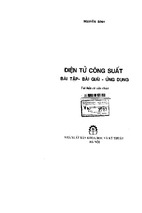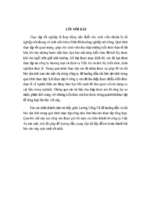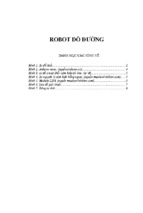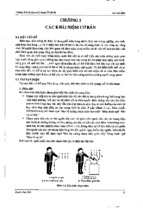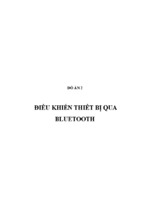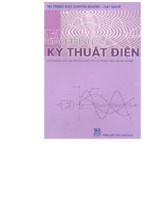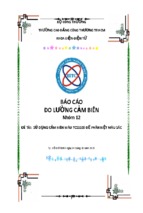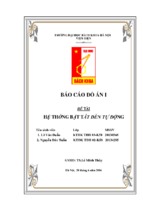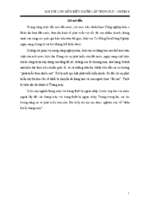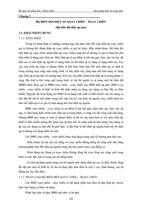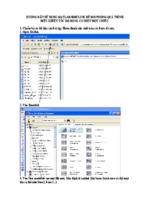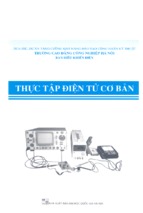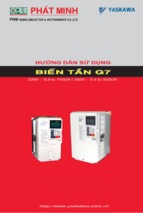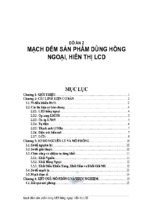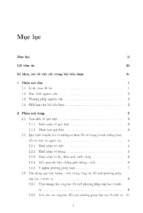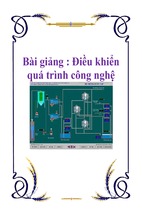For our other three free eBooks,
Go to: 1 - 100 Transistor Circuits
Go to: 101 - 200 Transistor Circuits
Go to: 50 - 555 Circuits
See TALKING ELECTRONICS WEBSITE
email Colin Mitchell:
[email protected]
INTRODUCTION
This is the third part of our Circuits e-book series. It contains a further 100
circuits. This time we have concentrated on circuits containing one or more IC's.
It's amazing what you can do with transistors but when Integrated Circuits came
along, the whole field of electronics exploded.
IC's can handle both analogue as well as digital signals but before their arrival,
nearly all circuits were analogue or very simple "digital" switching circuits.
Let's explain what we mean.
The word analogue is a waveform or signal that is changing (increasing and
decreasing) at a constant or non constant rate. Examples are voice, music,
tones, sounds and frequencies. Equipment such as radios, TV's and amplifiers
process analogue signals.
Then digital came along.
Digital is similar to a switch turning something on and off.
The advantage of digital is two-fold.
Firstly it is a very reliable and accurate way to send a signal. The signal is either
HIGH or LOW (ON or OFF). It cannot be half-on or one quarter-off.
And secondly, a circuit that is ON, consumes the least amount of energy in the
controlling device. In other words, a transistor that is fully turned ON and driving
a motor, dissipates the least amount of heat. If it is slightly turned ON or nearly
fully turned ON, it gets very hot.
And obviously a transistor that is not turned on at all will consume no energy.
A transistor that turns ON fully and OFF fully is called a SWITCH.
When two transistors are cross-coupled in the form of a flip flop, any pulses
entering the circuit cause it to flip and flop and the output goes HIGH on every
second pulse. This means the circuit halves the input pulses and is the basis of
counting or dividing. It is also the basis of a "Memory Cell" as will will hold a
piece of information.
Digital circuits also introduce the concept of two inputs creating a HIGH output
when both are HIGH and variations of this.
This is called "logic" and introduces terms such as "Boolean algebra" (Boolean
logic) and "gates."
Integrated Circuits started with a few transistors in each "chip" and increased to
mini or micro computers in a single chip. These chips are called Microcontrollers
and a single chip with a few surrounding components can be programmed to play
games, monitor heart-rate and do all sorts of amazing things. Because they can
process information at high speed, the end result can appear to have
intelligence and this is where we are heading: AI (Artificial Intelligence).
In this IC Circuits ebook, we have presented about 100 interesting circuits using
Integrated Circuits.
In most cases the IC will contain 10 - 100 transistors, cost less than the individual
components and take up much less board-space. They also save a lot of circuit
designing and quite often consume less current than discrete components or the
components they replace.
In all, they are a fantastic way to get something working with the least
componentry.
A list of of some of the most common Integrated Circuits (Chips) is provided at
the end of this book to help you identify the pins and show you what is inside the
chip.
Some of the circuits are available from Talking Electronics as a kit, but others
will have to be purchased as individual components from your local electronics
store. Electronics is such an enormous field that we cannot provide kits for
everything. But if you have a query about one of the circuits, you can contact
me.
Colin Mitchell
TALKING ELECTRONICS.
[email protected]
To save space we have not provided lengthy explanations of how the circuits
work. This has already been covered in TALKING ELECTRONICS Basic Electronics
Course, and can be obtained on a CD for $10.00 (posted to anywhere in the
world) See Talking Electronics website for more details:
http://www.talkingelectronics.com
MORE INTRO
We have said this before abut we will say it again: There are two ways to learn
electronics.
One is to go to school and study theory for 4 years and come out with all the
theoretical knowledge in the world but very little practical experience. The
other is to "learn on the job."
I am not saying one approach is better than the other but most electronics
enthusiasts are not "book worms" and many have been dissuaded from entering
electronics due to the complex mathematics surrounding University-type
courses.
Our method is to get around this by advocating designing, building, constructions
and even more assembly with lots of experimenting and when you get stuck with
a mathematical problem, get some advice or read about it via the thousands of
free test books on the web.
Anyone can succeed in this field by applying themselves to constructing projects.
You actually learn 10 times faster by doing it yourself and we have had lots of
examples of designs from students in the early stages of their career.
And don't think the experts get it right the first time. Look at all the recalled
electronics equipment from the early days.
The most amazing inventions have come from almost "newcomers" as evidenced
by looking through the "New Inventions" website.
All you have to do is see a path for your ideas and have a goal that you can add
your ideas to the "Word of Invention" and you succeed.
Nothing succeeds like success. And if you have a flair for designing things,
electronics will provide you a comfortable living for the rest of your life.
The market is very narrow but new designs are coming along all the time and
new devices are constantly being invented and more are always needed.
Once you get past this eBook of "Chips" you will want to investigate
microcontrollers and this is when your options will explode.
You will be able to carry out tasks you never thought possible, with a chip as
small as 8 pins and a few hundred lines of code.
In two weeks you can start to understand the programming code for a
microcontroller and perform simple tasks such as flashing a LED and produce
sounds and outputs via the press of a button.
All these things are covered on Talking Electronics website and you don't have to
buy any books or publications. Everything is available on the web and it is
instantly accessible. That's the beauty of the web.
Don't think things are greener on the other side of the fence, by buying a text
book. They aren't. Everything you need is on the web AT NO COST.
The only thing you have to do is build things. If you have any technical problem
at all, simply email Colin Mitchell and any question will be answered. Nothing
could be simpler and this way we guarantee you SUCCESS. Hundreds of readers
have already emailed and after 5 or more emails, their circuit works. That's the
way we work. One thing at a time and eventually the fault is found.
If you think a circuit will work the first time it is turned on, you are fooling
yourself.
All circuits need corrections and improvements and that's what makes a good
electronics person. Don't give up. How do you think all the circuits in these
eBooks were designed? Some were copied and some were designed from scratch
but all had to be built and adjusted slightly to make sure they worked perfectly.
I don't care if you use bread-board, copper strips, matrix board or solder the
components in the air as a "bird's nest." You only learn when the circuit gets
turned on and WORKS!
In fact the rougher you build something, the more you will guarantee it will work
when built on a printed circuit board.
However, high-frequency circuits (such as 100MHz FM Bugs) do not like open
layouts and you have to keep the construction as tight as possible to get them to
operate reliably.
In most other cases, the layout is not critical.
If you just follow these ideas, you will succeed.
A few of the basics are also provided in this eBook, the first is transistor
outlines:
TRANSISTORS
Most of the transistors used in our circuits are BC 547 and BC 557. These are
classified as "universal" or "common" NPN and PNP types with a voltage rating of
about 25v, 100mA collector current and a gain of about 100.
You can use almost any type of transistor to replace them and here is a list of
the equivalents and pinouts:
CONTENTS
Activate after 3 rings
Active for 1 second
Adjustable Voltage Supply
Alarm 4-Zone
AND Gate
Any Capacitor Value
Any Resistor Value
Battery Charger - Gell Cell
Battery-Low Beeper
BFO Metal Locator
Brake Lights (flash 3 times)
Burglar Alarm
Burglar Alarm 4-Zone
Clap Switch
Constant Current 20mA
CRO - 100 LED CRO
Current Limiting
Dice
Domino Effect
Flash LEDs for 20 Seconds
Gates
Gell Cell Battery Charger
Home Alarm
Intercom
Knight Rider - Kitt Scanner
Knight Rider for High-power LEDs
Knock Knock Doorbell
Ladybug Robot
Logic Gates
Logic Probe - Simple
Logic Probe with pulse
Long Duration Timer
Low-Battery Beeper
Mains Detector
Metal Detector - BFO
Phone Charger
Phone ring detector
Phone Ringer
Police Lights
Resistor Colour Code
Simple BFO Metal Locator
Simple Logic Probe
Solar Tracker
Timer - Long Duration
Transistor Tester - Combo-2
Water Level Pump Controller
Wheel Of Fortune
1.5v to 5v Phone Charger
2-Sector Burglar Alarm
4 Pumps
4-Zone Burglar Alarm
10 LED Chaser
10 Minute & 30 Minute Timer
10 Second Alarm
20mA Constant Current
100 LED CRO
LED CRO
LED Dice
LED Zeppelin - a game of skill
555
74c14
RESISTOR COLOUR CODE
THE 555
The 555 is everywhere. It is possibly the most-frequency used chip and is easy to use.
But if you want to use it in a "one-shot" or similar circuit, you need to know how the chip will "sit."
For this you need to know about the UPPER THRESHOLD (pin 6) and LOWER THRESHOLD
(pin 2):
The 555 is fully covered in a 3 page article on Talking Electronics website (see left index: 555
P1 P2 P3)
Here is the pin identification for each pin:
When drawing a circuit diagram, always draw the 555 as a building block with the pins in the
following locations. This will help you instantly recognise the function of each pin:
Note: Pin 7 is "in phase" with output Pin 3 (both are low at the same time).
Pin 7 "shorts" to 0v via the transistor. It is pulled HIGH via R1.
Maximum supply voltage 16v - 18v
Current consumption approx 10mA
Output Current sink @5v = 5 - 50mA @15v = 50mA
Output Current source @5v = 100mA @15v = 200mA
Maximum operating frequency 300kHz - 500kHz
Faults with Chip:
Consumes about 10mA when sitting in circuit
Output voltage up to 2.5v less than rail voltage
Output is 0.5v to 1.5v above ground
Sources up to 200mA but sinks only 50mA
HOW TO USE THE 555
There are many ways to use the 55.
(a) Astable Multivibrator - constantly oscillates
(b) Monostable - changes state only once per trigger pulse - also called a ONE SHOT
(c) Voltage Controlled Oscillator
ASTABLE MULTIVIBRATOR
The output frequency of a 555 can be worked out from the following graph:
The graph applies to the following Astable circuit:
The capacitor C charges via R1 and
R2 and when the voltage on the
capacitor reaches 2/3 of the supply, pin
6 detects this and pin 7 connects to 0v.
The capacitor discharges through R2
until its voltage is 1/3 of the supply and
pin 2 detects this and turns off pin7 to
repeat the cycle.
The top resistor is included to prevent
pin 7 being damaged as it shorts to 0v
when pin 6 detects 2/3 rail voltage.
Its resistance is small compared to R2
and does not come into the timing of
the oscillator.
Using the graph:
Suppose R1 = 1k, R2 = 10k and C = 0.1 (100n).
Using the formula on the graph, the total resistance = 1 + 10 + 10 = 21k
The scales on the graph are logarithmic so that 21k is approximately near the "1" on the 10k.
Draw a line parallel to the lines on the graph and where it crosses the 0.1u line, is the answer.
The result is approx 900Hz.
Suppose R1 = 10k, R2 = 100k and C = 1u
Using the formula on the graph, the total resistance = 10 + 100 + 100 = 210k
The scales on the graph are logarithmic so that 210k is approximately near the first "0" on the
100k. Draw a line parallel to the lines on the graph and where it crosses the 1u line, is the
answer. The result is approx 9Hz.
The frequency of an astable circuit can also be worked out from the following formula:
frequency =
1.4
(R1 + 2R2) × C
555 astable frequencies
R1 = 1k R1 = 10k R1 = 100k
R2 = 6k8 R2 = 68k R2 = 680k
C
0.001µ 100kHz
10kHz
1kHz
0.01µ
10kHz
1kHz
100Hz
0.1µ
1kHz
100Hz
10Hz
1µ
100Hz
10Hz
1Hz
10µ
10Hz
1Hz
0.1Hz
The simplest Astable uses one
resistor and one capacitor. Output pin
3 is used to charge and discharge the
capacitor.
LOW FREQUENCY OSCILLATORS
If the capacitor is replaced with an
electrolytic, the frequency of oscillation
will reduce. When the frequency is less
than 1Hz, the oscillator circuit is called
a timer or "delay circuit." The 555 will
produce delays as long as 30 minutes
but with long delays, the timing is not
accurate.
555 Delay Times:
C
R1 = 100k R1 = 470k R1 = 1M
R2 = 100k R2 = 470k R2 = 1M
10µ
2.2sec
10sec
22sec
100µ
22sec
100sec
220sec
470µ
100sec
500sec
1000sec
555 ASTABLE OSCILLATORS
Here are circuits that operate from 300kHz to 30 minutes:
(300kHz is the absolute maximum as the 555 starts to malfunction with irregular bursts of pulses
at this high frequency and 30 minutes is about the longest you can guarantee the cycle will
repeat.)
SQUARE WAVE OSCILLATOR
A square wave oscillator kit can be purchased
from Talking Electronics for approx $10.00
See website: Square Wave Oscillator
It has adjustable (and settable) frequencies from
1Hz to 100kHz and is an ideal piece of Test
Equipment.
555 Monostable or "one Shot"
50 - 555 CIRCUITS
50 555 Circuits eBook can be accessed on the web or
downloaded as a .doc or .pdf It has more than 50 very
interesting 555 circuits and data on using a 555.
Table of Contents: (more has been added - see: 50 - 555 circuits)
Active High Trigger
Active Low Trigger
Amplifier using 555
Astable Multivibrator
Bi-Coloured LED
Bi-Polar LED Driver
Car Tachometer
Clark Zapper
Clicks Uneven
Continuity Tester
Dark Detector
Driving A Bi-Coloured LED
Driving A Relay
Flashing Indicators
Flashing Railroad Lights
Flip Flop
Function of each 555 pin
Hee Haw Siren
High Frequency 555 Oscillator
How to use the 555
Increasing Output Current
Increasing Output Push-Pull
Current
Inverter 12v to 240v
Inside the 555
Kitt Scanner
Knight Rider
Laser Ray Sound
Latch
One-Shot 555
Organ
Police Siren
Pulse Extender
Pulser - 74c14
PWM Controller
Railroad Lights (flashing)
Rain Alarm
Replacing 556 with two 555's
Resistor Colour Codes
Screamer Siren - Light
Controlled
Servo Tester
Simplest 555 Oscillator
Siren 100dB
Square Wave Oscillator
Stun Gun
Substituting a 555 - Part 1
Substituting a 555 - Part 2
Switch Debounce
Tachometer
Ticking Bomb
Tilt Switch
Touch Switch
Toy Organ
Transistor Tester
Trigger Timer - 74c14
Uneven Clicks
Using the 555
LED Dimmer
Light Controlled Screamer Siren
Light Detector
Low Frequency 555 Oscillator
Machine Gun
Memory Cell
Metal Detector
Monostable 555
Morse Keyer
Mosquito Repellent
Motor PWM
Multivibrator - Astable
Negative Voltage
Normally Closed Trigger
Voltage Doubler
Wailing Siren
Zapper (Dr Clark)
Zener Diode Tester
2 Minute Timer - 74c14
10 Minute Timer - 74c14
12v to 240v Inverter
100dB Siren
555 Amplifier
555 Kit of Components
555 Pinout
555 Mistakes (No-No's)
556 Dual Timer
KNOCK KNOCK DOORBELL
This very clever circuit only produces an output when the piezo detects two taps. It can be used
as a knock-knock doorbell. A PC board containing all components (soldered to the board) is
available from talking electronics for $5.00 plus postage. Email HERE for details.
The circuit takes only a few microamp and when a tap is detected by the piezo, the waveform
from the transistor produces a HIGH on pin 6 and the HIGH on pin 5 makes output pin 4 go low.
This very quickly charges the 47n and it is discharged via the 560k to produce a brief pulse at pin
3.
The 47n is mainly to stop noise entering pin 2. Pin 1 is HIGH via the 2M7 and the LOW on pin 2
causes pin 3 to produce a HIGH pulse. The 47n is discharged via the internal diodes on pin 13
and when it goes LOW, pin 11 goes HIGH and charges the 10n via the 22k and diode.
This puts a HIGH on pin 8 for approx 0.7 seconds and when a second tap is detected, pin 9 sees
a HIGH and pin 10 goes LOW. This puts a LOW on pin 12 and a HIGH on pin 8. The LOW on pin
12 goes to pin 1. A HIGH and LOW on the second NAND gate produces a HIGH on pin 3 and the
third NAND gate has a HIGH on both inputs. This makes pin 10 LOW and the 4u7 starts to
charge via the 2M7 resistor. After 5 seconds pin 12 sees a HIGH and pin 11 goes LOW. The 10n
is discharged via the 10M and when pin 8 sees a LOW, pin 10 goes HIGH. The output sits HIGH
and goes LOW for about 7 seconds.
LED ZEPPELIN
This circuit is a game of skill. See full article: LED Zeppelin. The kit is available
from talking electronics for $15.50 plus postage. Email HERE for details.
The game consists of six LEDs and an indicator LED that flashes at a rate of about 2
cycles per second. A push button is the "Operations Control" and by carefully
pushing the button in synchronisation with the flashing LED, the row of LEDs will
gradually light up.
But the slightest mistake will immediately extinguish one, two or three LEDs. The
aim of the game is to illuminate the 6 LEDs with the least number of pushes.
We have sold thousands of these kits. It's a great challenge.
LED Zeppelin Project - A Game of Skill
BFO METAL DETECTOR
The circuit shown must represent the limits of simplicity for a metal detector. It uses a single 4093 quad
Schmitt NAND IC and a search coil -- and of course a switch and batteries. A lead from IC1d pin 11
needs to be attached to a MW radio aerial, or should be wrapped around the radio. If the radio has a
BFO switch, switch this ON.
Since an inductor resists rapid changes in voltage (called reactance), any change in the logic level at
IC1c pin 10 is delayed during transfer back to input pins 1 and 2. This is further delayed through
propagation delays within the 4093 IC. This sets up a rapid oscillation (about 2 MHz), which is picked up
by a MW radio. Any change to the inductance of L1 (through the presence of metal) brings about a
change to the oscillator frequency. Although 2 MHz is out of range of the Medium Waves, a MW radio
will clearly pick up harmonics of this frequency.
The winding of the coil is by no means critical, and a great deal of latitude is permissible. The prototype
used 50 turns of 22 awg/30 swg (0.315 mm) enamelled copper wire, wound on a 4.7"/120 mm former.
This was then wrapped in insulation tape. The coil then requires a Faraday shield, which is connected to
0V. A Faraday shield is a wrapping of tin foil around the coil, leaving a small gap so that the foil does not
complete the entire circumference of the coil. The Faraday shield is again wrapped in insulation tape. A
connection may be made to the Faraday shield by wrapping a bare piece of stiff wire around it before
adding the tape. Ideally, the search coil will be wired to the circuit by means of twin-core or figure-8
microphone cable, with the screen being wired to the Faraday shield.
The metal detector is set up by tuning the MW radio to pick up a whistle (a harmonic of 2 MHz). Note
that not every such harmonic works best, and the most suitable one needs to be found. The presence of
metal will then clearly change the tone of the whistle. The metal detector has excellent stability, and it
should detect a large coin at 80 to 90 mm, which for a BFO detector is relatively good. It will also
discriminate between ferrous and non-ferrous metals through a rise or fall in tone.
Copyright Rev. Thomas Scarborough
The author may be contacted at
[email protected]
SIMPLE BFO METAL LOCATOR
This circuit uses a single coil and nine components to make a
particularly sensitive low-cost metal locator. It works on the principle
of a beat frequency oscillator (BFO).
The circuit incorporates two oscillators, both operating at about
40kHz. The first, IC1a, is a standard CMOS oscillator with its
frequency adjustable via VR1.
The frequency of the second, IC1b, is highly dependent on the
inductance of coil L1, so that its frequency shifts in the presence of
metal. L1 is 70 turns of 0.315mm enamelled copper wire wound on a
120mm diameter former. The Faraday shield is made of aluminum
foil, which is wound around all but about 10mm of the coil and
connected to pin 4 of IC1b.
The two oscillator signals are mixed through IC1c, to create a beat
note. IC1d and IC1c drive the piezo sounder in push-pull fashion,
thereby boosting the output.
Unlike many other metal locators of its kind, this locator is
particularly easy to tune. Around the midpoint setting of VR1, there
will be a loud beat frequency with a null point in the middle. The
locator needs to be tuned to a low frequency beat note to one or the
other side of this null point.
Depending on which side is chosen, it will be sensitive to either
ferrous or non-ferrous metals. Besides detecting objects under the
ground, the circuit could serve well as a pipe locator.
1.5v to 5v PHONE CHARGER
Look at the photos. The circuit is simple. It looks like two surface-mount transistors, an inductor, diode,
capacitor, resistor and LED.
But you will be mistaken.
One of the "transistors" is a controller and the other is a FET.
The controller is powered from the output (5v) of the circuit and when it detects no-load, it shuts down
and requires a very small current.
When the 1v5 batter is connected, the controller starts up at less than 1v5 due to the Schottkey diode
and charges the 1u capacitor by driving the FET and using the flyback effect of the inductor to produce
a high voltage. When the output voltage is 5v, the controller turns off and the only load on the 1u is the
controller. When the voltage drops across this capacitor, the controller turns on in bursts to keep the
1u charged to exactly 5v. The charger was purchased for $3.00 so it is cheaper to buy one and use it
in your own project. It also comes with 4 adapter leads!
The AA case and 4 adapter leads - cost: $3.00!!
The controller has been placed on extension wires to test its operation.
The LED and 1u capacitor can be clearly
seen in this photo.
Sometimes it is better to use something that is already
available, rather than trying to re-invent the wheel. This
is certainly the case with this project. You could not buy
the components for the cost of the complete phone
charger and extension leads.
The circuit will deliver 70mA at 5v and if a higher
current is drawn, the voltage drops slightly.
These chargers were originally priced at $30.00 !!
10 SECOND ALARM
This circuit is activated for 10 seconds via the first two gates. They form a LATCH to keep the oscillator
(made up of the next two gates) in operation, to drive the speaker.
The circuit consumes a few microamps in quiescent mode and the TOUCH PLATES can be any type of
foil on a door knob or item that is required to be protected. The 10u sits in an uncharged condition and
when the plates are touched, the voltage on pin 1 drops below 50% rail and makes pin 3 HIGH. This
pulls pins 5 and 6 HIGH and makes pin 4 LOW. This keeps pin 3 HIGH, no matter if a HIGH or LOW is
on pin1. This turns on the oscillator and the 10u starts to charge via the 100k resistor. After about 10
seconds, the voltage on pins 5 and 6 drops to below 50% rail voltage and pin 4 goes HIGH. If the
TOUCH PLATES are not touched, pin 3 will go LOW and the oscillator will stop.
USING A VOLTAGE REGULATOR
This circuit shows how to use a voltage regulator to convert a 24v supply to
12v for a 555 chip. Note: the pins on the regulator (commonly called a 3terminal regulator) are: IN, COMMON, OUT and these must match-up with:
In, Common, Out on the circuit diagram.
If the current requirement is less than 500mA, a 100R "safety resistor" can
be placed on the 24v rail to prevent spikes damaging the regulator.
POLICE LIGHTS
These three circuits flash the left LEDs 3 times then the right LEDs 3 times, then repeats. The
only difference is the choice of chips.
FLASH LEDS FOR 20 SECONDS
This circuit comes from a request from a reader. It flashes a LED for
20 seconds after a switch is pressed. In other words, for 20 seconds
as soon as the switch is pressed. The values will need to be
adjusted to get the required flash-rate and timing.
INTERCOM
This circuit uses a single transistor and LM386 amplifier IC to produce an intercom that allows handsfree operation.
As both microphones and loudspeakers are always connected, the circuit is designed to avoid feedback
- known as the "Larsen effect".
The microphone amplifier transistor is 180° phase-shifted and one of the audio outputs is taken at the
collector and its in-phase output taken at the emitter. These are mixed by the 10u, 22u, 20k pot and 2k7
so that the two signals almost cancel out. In this way, the loudspeaker will reproduce a very faint copy
of the signals picked-up by the microphone.
At the same time, as both collectors of the two intercom units are tied together, the 180° phase-shifted
signal will pass to the audio amplifier of the second unit without attenuation, so it will be loudly
reproduced by its loudspeaker.
The same operation will occur when speaking into the microphone of the second unit. When the 20k pot
is set correctly, almost no output will be heard from the loudspeaker but a loud and clear reproduction
will be heard at the output of the other unit. The second 20k pot adjusts the volume.
ACTIVATE VIA 3 PHONE RINGS
This circuit connects to a phone line. When the phone rings for 3 or 4 rings, the relay is activated for
about 1 minute. But if the phone rings for 6 or more rings, the circuit is not activated.
The circuit takes less than 100uA when in quiescent state and when the phone rings, the ring voltage is
passed to pin 1 via the 100k and 100n capacitor. This causes pin 2 to go HIGH and charge two 100u
electrolytics. The lower 100u charges in 7 seconds and the upper charges in 12 seconds. If the phone
rings for only 3 rings, pin 4 goes LOW and charges the third 100u via a 47k resistor. After a further 7
seconds, pin 10 goes HIGH. If the phone stops ringing after 3 rings, the lower 100u starts to discharge
via the 470k and after about 40 seconds pin 4 goes HIGH. The third 100u now starts to discharge via
the 470k across it and the relay turns off.
If the phone rings for more than 5 rings, the top 100u will charge and pin 6 will go LOW and cause pin 8
to go HIGH and prevent pin 11 going LOW via the gating diode.
WATER LEVEL PUMP CONTROLLER
This circuit provides automatic level control of a water tank.
The shorter steel rod is the "water high" sensor and the longer is the "water low" sensor. When the
water level is below both sensors, pin 10 is low. If the water comes in contact with the longer sensor the
output remains low until the shorter sensor is reached. At this point pin11 goes high and the transistor
conducts. The relay is energized and the pump starts operating. When the water level drops the shorter
sensor will be no longer in contact with the water, but the output of the IC will keep the transistor tuned
ON until the water falls below the level of the longer rod. When the water level falls below the longer
sensor, the output of the IC goes low and the pump will stop.
The switch provides reverse operation. Switching to connect the transistor to pin 11 of the IC will cause
the pump will operate when the tank is nearly empty and will stop when the tank is full. In this case, the
pump will be used to fill the tank and not to empty it.
Note: The two steel rods must be supported by a small insulated (wooden or plastic) board. The circuit
can be used also with non-metal tanks, provided a third steel rod having about the same height as the
tank is connected to the negative.
Adding an alarm to pin 11 will let you know the tank is nearly empty.
BRAKE LIGHTS
This circuit makes the brake lights flash a number of times then stay ON. The circuit shows how a MOSFET
works. The MOSFET is turned on with a voltage between the gate and source. This occurs in the circuit when
the gate is LOW. The P-channel MOSFET can be replaced by a PNP transistor with the addition of a 2k2
between the diode and base, to prevent the transistor being damaged when output pin 3 goes LOW. Ideally the
PNP transistor should be replaced with a Darlington transistor.
This circuit originally designed by:
Ken Moffett
Scientific Instrumentation
Macalester College
1600 Grand Avenue
St Paul MN 55105
[email protected]
See the full article:
http://www.sentex.net/~mec1995/circ/motflash.html
.pdf of article
ACTIVE FOR 1 SECOND
This circuit is active for 1 second after it detects a signal on the base of the input transistor. The length
of activation depends on the value of the resistor across the 10u electrolytic.
When pin 1 goes LOW, pin 2 goes HIGH and charges the 10u. Pin 3 goes HIGH, pin 4 goes LOW and
pin 6 goes HIGH to turn on the transistor and activate the relay.
At the same time a HIGH is passed to pin 1 to keep it HIGH.
Pin 2 will be kept LOW and the 10u will discharge via the resistor across it and eventually pin 3 will go
LOW and the relay will turn off. If a signal is still present on the base of the input transistor, the relay will
remain energised as the circuit will charge the 10u again.


